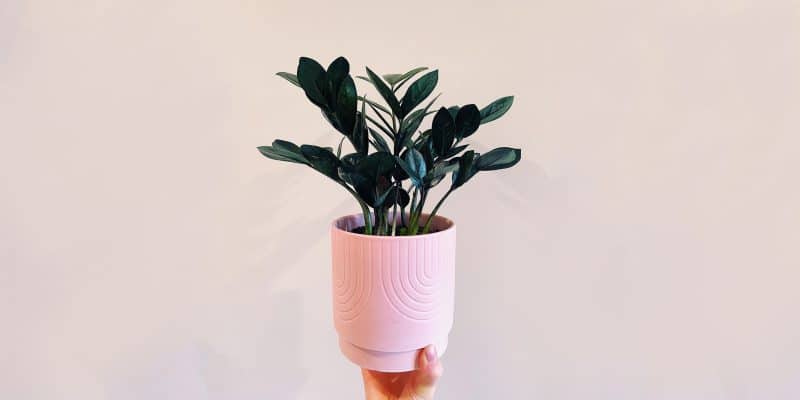Ready to meet the fabulous and alluring Raven ZZ Plant? With its striking black leaves and easy-going growth habits, this captivating cultivar has become a must-have addition to many plant lovers’ collections.
You see, the Raven ZZ Plant isn’t just all about good looks. This hardy beauty is also a low-maintenance superstar, perfect for both seasoned green-thumbs and newbies alike.
We’ll kick off by painting a picture of this eye-catching plant, including its growth habits (did someone say “rhizomes”?). Then, we’ll dish out the dirt on the ZZ Raven’s unique appearance, from its gorgeous green sprouts to those envy-inducing ebony leaves.
And of course, we’ll make sure you’re all set to care for your new botanical buddy by sharing our top care tips and tricks.
Let’s dive head-first into the marvelous world of Raven ZZ plant care and learn everything there is to know about this stunning, conversation-starting houseplant.
Table of Contents
Raven ZZ Plant Plant Care Guide
History, Habitat, and Characteristics
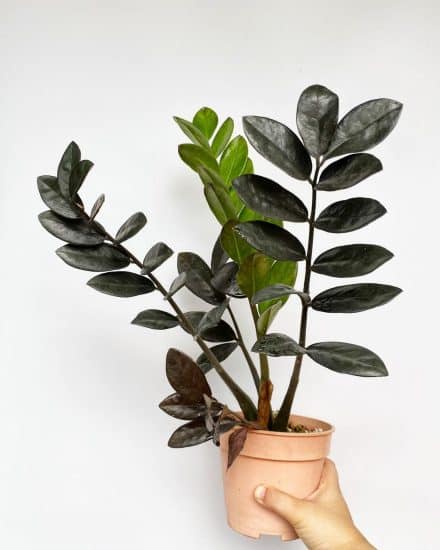
Ready to meet a real stunner? Say hello to the mysterious and beautiful Raven ZZ Plant (Zamioculcas zamiifolia ‘Raven’, sometimes called Zamioculcas zamiifolia ‘Dowon’), a rare plant with a unique appearance.
Hailing from East Africa, this indoor plant boasts shiny black leaves and has made quite a name for itself within the ZZ plant family.
What’s even more exciting? This slow-growing, trademarked cultivar was designed to be easy to care for, making it a favorite among both seasoned and newbie plant lovers.
Spreading rhizomes through the soil, it occasionally surprises you with fresh, new shoots. These shoots start out as a bright green color and gradually transform into those mesmerizing dark black leaves.
The Raven ZZ Plant is the perfect combo of good looks, historical charm, and adaptability. With its alluring dark leaves, fascinating growth pattern, and laid-back care needs, it’s no wonder this plant has become a beloved addition to the ZZ family and our indoor jungles.
What is the difference between the ZZ plant and ZZ Raven?
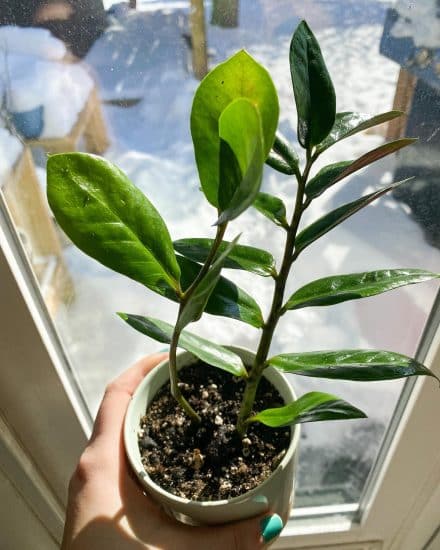
While the standard ZZ plant (Zamioculcas zamiifolia) and the Raven ZZ plant are close siblings, they boast a noticeable difference in their appearance.
The traditional ZZ plant features lush, shiny green leaves, while the Raven ZZ plant stands out with its captivating deep purple-black foliage.
Both plants share similar ease in care, adaptability, and resilience, making them fantastic indoor plants. It all comes down to your personal preference—go for the classic bright green color, or add a dash of mysterious charm with the Raven ZZ.
How long does it take for Raven ZZ to turn black?
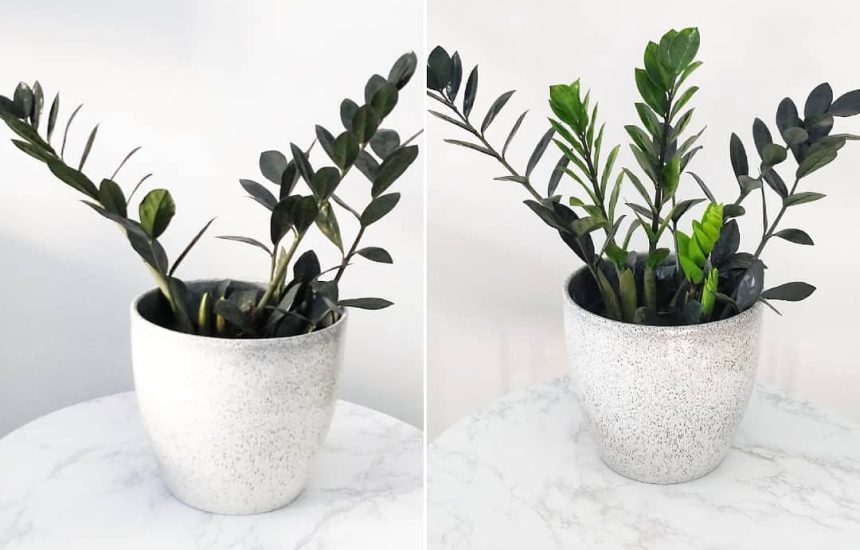
The timeframe for the Raven ZZ’s leaves to transform from bright green to its gorgeous, shiny black can vary, but it typically takes about six to eight weeks to fully darken.
Of course, the exact duration might differ based on factors like the amount of light exposure and overall plant health. So, be patient and enjoy the fascinating color-changing process. Your Raven ZZ is on its way to showcasing its full dark glamour!
Light
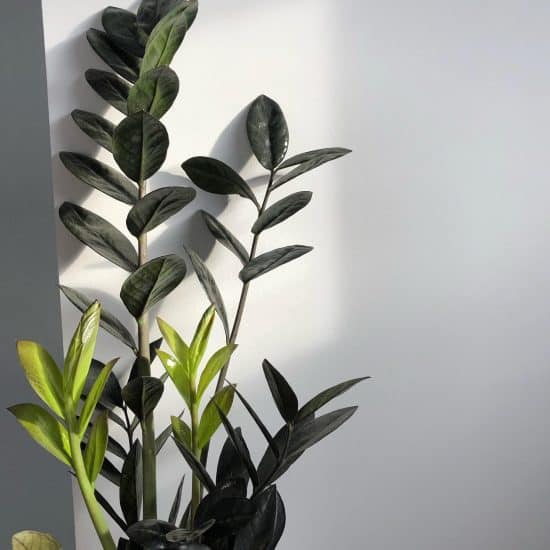
Let’s dive into how you can provide the perfect light conditions for ZZ Raven plants.
These plants enjoy bright, indirect light, but did you know they can even handle some direct sunlight as well? It’s true!
However, it’s best not to throw them straight into full sun… Instead, aim for a medium light near an east-facing window or with southeast exposure. This way, your plant can soak up some gentle morning sunlight without getting scorched by those more intense afternoon rays.
Now, what if your plant isn’t getting enough light? Well, you might notice slow, leggy growth or leaves losing their dark glossy shine. On the other hand, too much direct sunlight can lead to brown, faded leaves.
So, how can you strike the perfect balance?
- If your Raven ZZ Plant seems to be craving more light, try moving it to a brighter spot with more indirect sunlight. After all, the right amount of light leads to healthy growth!
- Worried about your plant getting too much direct light? No problem — just add a sheer curtain to filter sunlight or move it away from harsh afternoon rays. Easy peasy!
- Don’t forget to rotate your plant every few weeks for even growth. This way, one side won’t end up leggier or with fewer leaves than the other.
Water
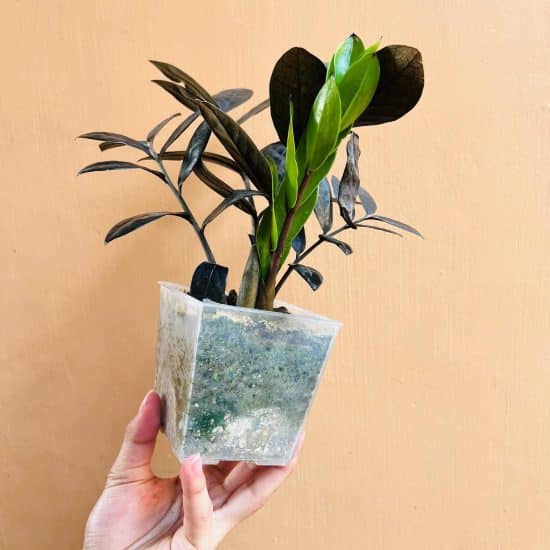
Raven ZZ plants are super forgiving, but it’s still important to find that perfect balance between too much and too little water.
So, the first thing you need to know is that light conditions play a big role in how often you should water your plant. The more light your Raven ZZ plant gets, the more water it can handle.
ZZ plants can go for quite a while without water, all thanks to those tuber-like rhizomes that store moisture and nutrients.
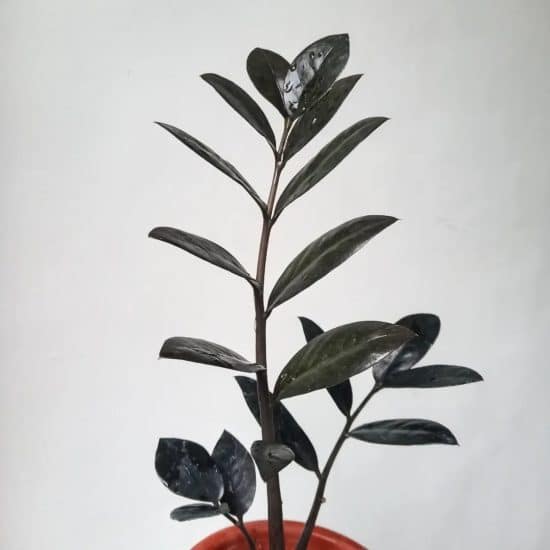
If your Raven ZZ’s bright green new growth and shiny leaves are dry, curling, or turning brown, it’s time to up the ante on the watering schedule. Once you do that, your plant should perk right back up!
If you notice yellowing leaves or mushy stems, it might be getting too much water. In this case, ease up on the watering, allowing the soil to dry out more between waterings (remember, it’s better to underwater than overwater these plants).
Temperature and humidity
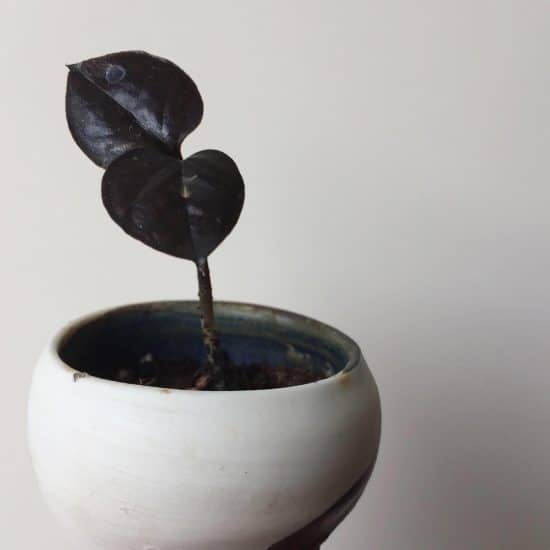
Caring for your Raven ZZ plant means understanding its ideal temperature and humidity conditions.
As a tropical plant, it prefers warm indoor temperatures generally between 65-80 degrees Fahrenheit. Although it can tolerate some drafts from an open window, it’s essential to avoid exposing the plant to freezing conditions, as this can shock itand potentially cause damage.
During the winter season, you’ll want to keep your plant away from cold drafts, such as open windows or exterior doors. If you’re transporting your plant in the winter, make sure to cover it and keep it warm during the journey, as it is sensitive to drops in temperature.
Now, let’s talk about humidity. The Raven ZZ plant is relatively adaptable when it comes to humidity levels. Normal household levels should be just fine. If the leaves appear shriveled or wrinkled, it could be an indication of too little humidity in the environment.
Temperature and humidity care tips:
- Keep your Raven ZZ plant in temperature ranges between 65-80°F, away from cold drafts and freezing conditions.
- It can adapt to various humidity levels, but watch for signs of too much or too little humidity.
- Use a humidifier or a pebble tray to help maintain proper humidity levels.
Soil and planting
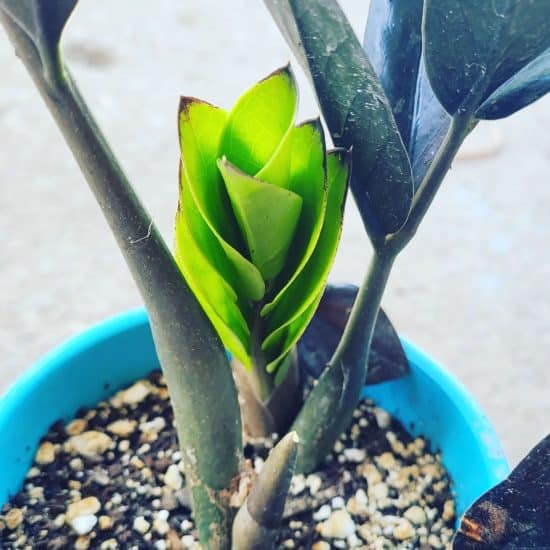
To provide the best possible environment for your black Raven ZZ Plant or Zamioculcas zamiifolia, the right soil is crucial. This plant will thrive in a fast-draining soil mix, like a cactus/succulent mix, which allows for proper aeration and drainage.
Avoid using regular potting soil, as it tends to retain too much moisture and can lead to rot. If you do have potting soil to use, make sure to add plenty of perlite, 40% or more.
Repotting
The slow-growing nature of the Raven ZZ Plant means repotting will likely only be required every few years. When it’s time to repot, select a pot that’s only slightly larger than its current one, since too much soil volume leaves the soil wet for too long.
Choose a pot with drainage holes to prevent waterlogging and root rot. Gently transfer the plant to its new pot, taking care not to damage the roots, and fill it with a fast-draining soil mix.
Propagation
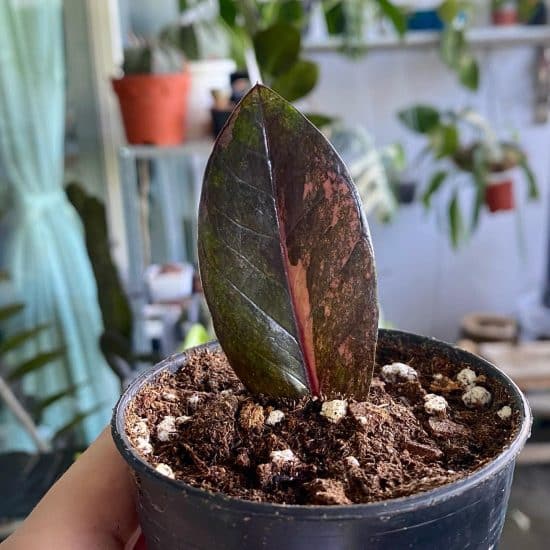
While rhizome division works like a charm, you can also propagate Raven ZZ plants using stem cuttings. It might take a few months for your cuttings to grow strong roots, but the wait is worth it when you’ll have thriving new plants.
We’ll show you two ways to get more Raven ZZ Plants: rhizome division and stem cuttings in water.
Propagating with rhizome division:
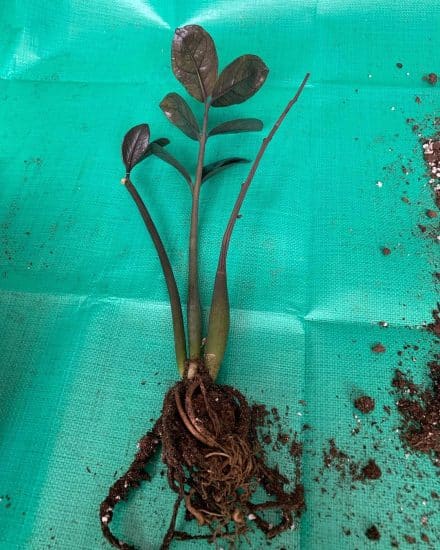
Get your workspace ready by grabbing a sterilized knife, a fresh pot with well-draining soil and drainage hole, and your Raven ZZ plant.
- Gently take your plant out of its current pot and give it a lil shake to free up the roots and thick rhizomes from the excess soil.
- Find a healthy rhizome to work with, making sure it’s got at least one strong stem and leaves attached.
- Divide and conquer by carefully separating that rhizome with your trusty sterilized knife, detaching it from the rest of the plant.
- Plant in the fresh pot with soil, give it a drink of water, and place it in a spot with bright, indirect light, such as near an east-facing window.
Propagating Raven ZZ with stem cuttings in water:
- Choose a strong stem, one with a main stem and a few leaves showing off. Make sure your gardening shears or sharp knife are clean and sterile for a neat cut.
- Remove any leaves from the bottom, clearing the lower nodes for some root action.
- Place that stem in a container filled with water (no submerged leaves, though!). Find a place with bright, indirect light for your cutting to chill, like near a bright window.
- Keep the water fresh by changing it every few days, stopping any bacterial growth.
Keep an eye on those roots over the coming months. Once they’re at least 1-2 inches long, it’s time to move the cutting to a pot with well-draining soil.
With both methods, you should keep humidity as high as possible. We recommend a clear plastic bag, cut 2-liter bottle, or some Tupperware over your pot to trap in moisture and encourage new growth.
Common Issues
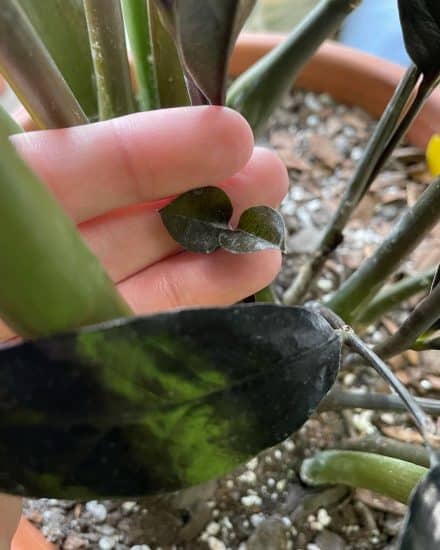
We know you’re doing your best to take care of your Raven ZZ plant, but sometimes, even the most resilient plants can have a few issues. No worries, though — we’re here to help you identify and fix the problems we see most frequently.
Yellow leaves
You know what they say, “too much of a good thing” can be a bad thing? Well, it turns out overwatering is a common issue for our Raven ZZ plant care friends. If you notice yellowing leaves that seem to fall off way too easily, and soil that feels more like a swamp than a comfy home, it might be time to step back on the watering.
To set things right, let the top inch of soil dry out before giving your plant another drink. Make sure you’ve got a pot with drainage holes (nobody likes soggy feet, right?) and try a well-draining soil mix.
Oh, and don’t forget — a pot that’s just the right size can make a world of difference.
Fading Leaves
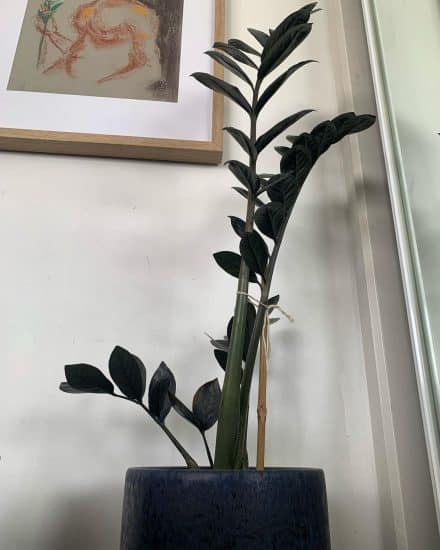
Is your plant looking a bit less… ravishing? If those luscious dark purple leaves are starting to fade, it might be time to think about how much light they’re getting. These beauties prefer bright, indirect light, so if they’re not getting enough, they’ll let you know by losing their vibrant color.
Here’s a fix for those very low light conditions: find a spot where your plant can bask in bright, indirect light, like near a window with a sheer curtain. Just be careful not to let it soak up direct sunlight or low light for long periods, or you’ll end up with sunburned leaves (and nobody wants that!).
Pests and diseases
ZZ plants tend to be drought tolerant, tough cookies, and usually easy-going, but from time to time, they might face some common pests or get a little sick.
Spider mites
Okay, let’s talk pests. While your black ZZ Plant is mostly pest-resistant (lucky us!), sneaky spider mites can sometimes come to pester it. These little troublemakers thrive in a low humidity environment, dry, or dusty conditions and love feasting on the sap of the plant, leaving the leaves all speckled and sad-looking.
First, let’s get your ZZ Black Raven plant away from the other plants – we don’t want those mites spreading. Next, grab a damp cloth and give the leaves and stems a good wipe-down, being extra thorough with the undersides of the leaves (that’s where those mites love to hide).
You’ll want to use neem oil or general insecticidal soap, applying to all the nooks and crannies.
Root rot
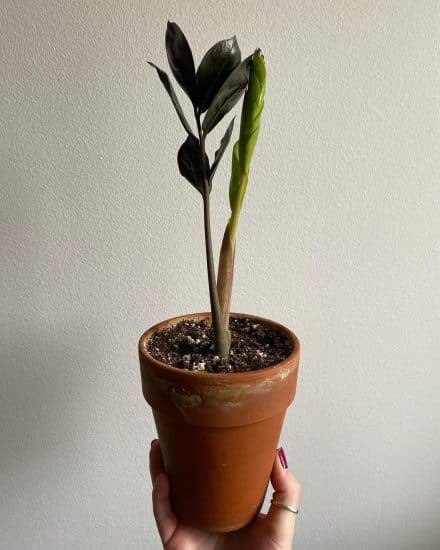
To figure out if your plant suffers from root rot, watch out for drooping, yellow leaves. If it’s really bad, you’ll see your plant losing its balance and looking like it’s about to topple over.
Carefully take your plant out of its pot and scrutinize those roots. Any mushy, slimy, or rotten-looking roots? Cut ’em away and make sure to sterilize your tools before and after. Then, repot your plant in fresh soil that’s well-draining and mixed with perlite or pumice to get that aeration and drainage just right.
Make sure you’re not overwatering your plant – wait until the soil dries out a bit before giving it a drink. And remember, Raven ZZ Plants store water in their thick petiole, so they’ll be all right going a bit longer without water.
Conclusion
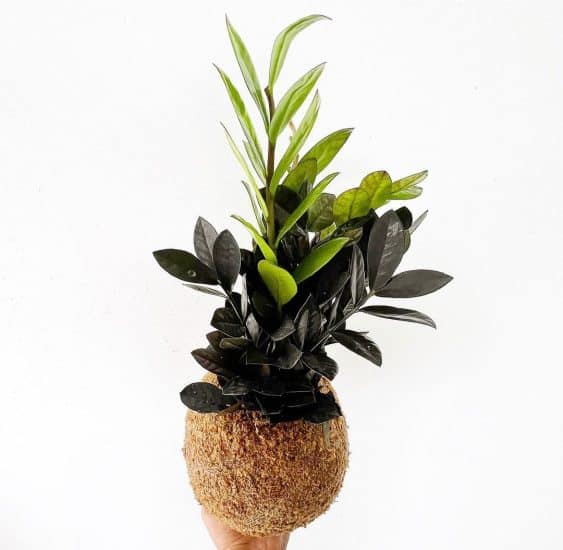
That’s a wrap on our Raven ZZ Plant care guide!
With its enchanting black leaves and easy-going personality, the Raven ZZ Plant (Zamioculcas zamiifolia ‘Raven‘) is a wonderful addition to any indoor garden.
Its low-maintenance nature and adaptability make it perfect for plant experts and beginners alike. Plus, you’ll have a captivating conversation piece that brings a touch of botanical history to your home!
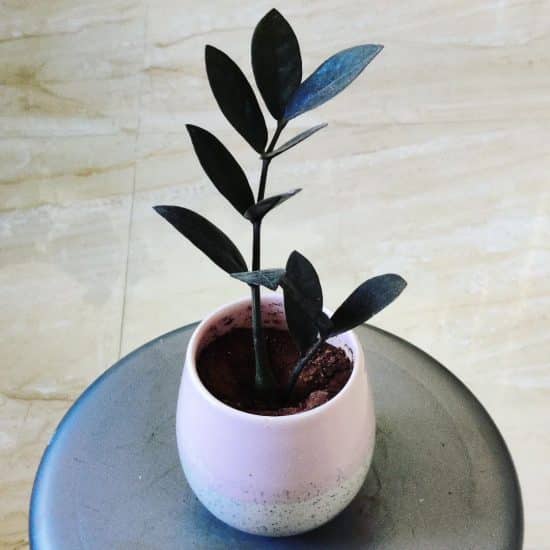
Raven ZZ Plant care summary:
- Provide bright, indirect light or medium light exposure, avoiding direct sunlight to prevent sunburned leaves.
- Water every 10 days to 2 weeks in brighter spots and once a month in low-light areas, ensuring well-draining soil to prevent root rot.
- Keep temperatures between 65-80°F and avoid exposing your plant to cold drafts or freezing conditions.
- Use a fast-draining soil mix such as a succulent/regular potting soil mix, or add perlite to a regular potting mix.
We hope this guide has equipped you with all the knowledge you need to care for your Raven ZZ Plant successfully.
If you have any further questions or need extra advice, don’t hesitate to reach out to us. Happy growing, and enjoy the mesmerizing beauty of your Raven ZZ Plant!
Take care!
FAQ
Can the ZZ Raven Plant flower?
Yes, indeed! The ZZ Raven Plant is quite a showstopper, and it even offers an occasional floral surprise. Although flowering is less common when grown indoors, it’s still possible for your ZZ Raven to produce tiny, inconspicuous flowers.
They typically sprout at the base and are enclosed in a spathe, similar to other aroid plants. While the flowers might not steal the show compared to the stunning black foliage, it’s always a delight to see your plant friend bloom!
Is the ZZ Raven Plant patented?
The Raven ZZ Plant is a trademarked cultivar (Zamioculcas zamiifolia ‘Dowon’) that holds a Plant Patent. If you’re thinking about selling these commercially, you’ll want to check in with Costa Farms before breaking out the ol’ money bag.
Sources
- https://plants.ces.ncsu.edu/plants/zamioculcas-zamiifolia-dowon/

